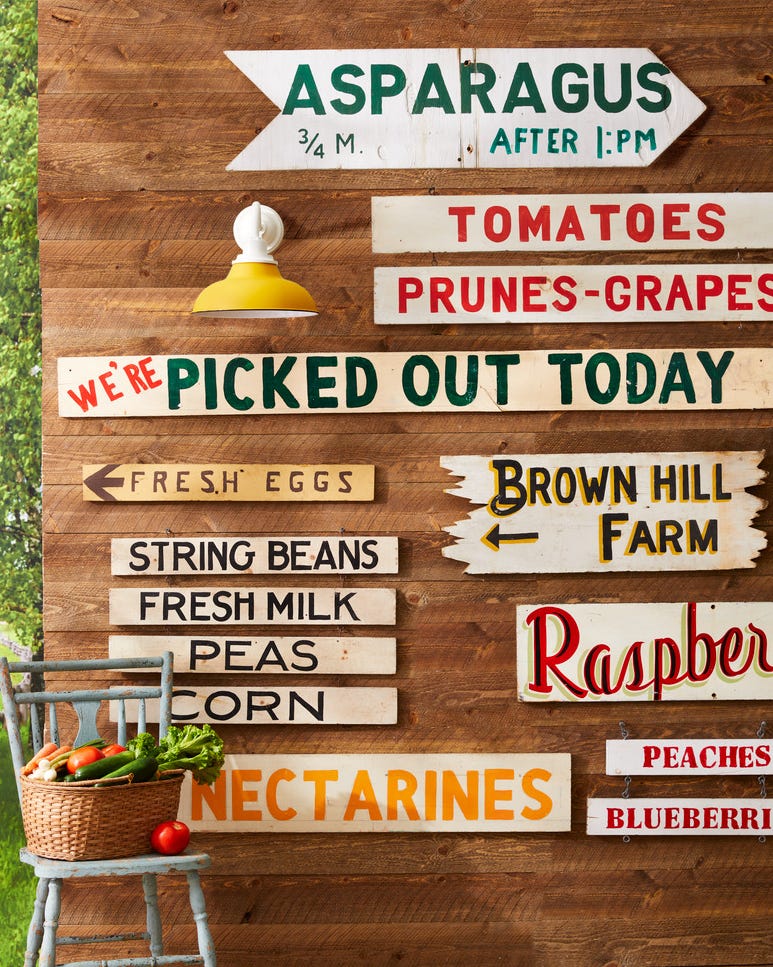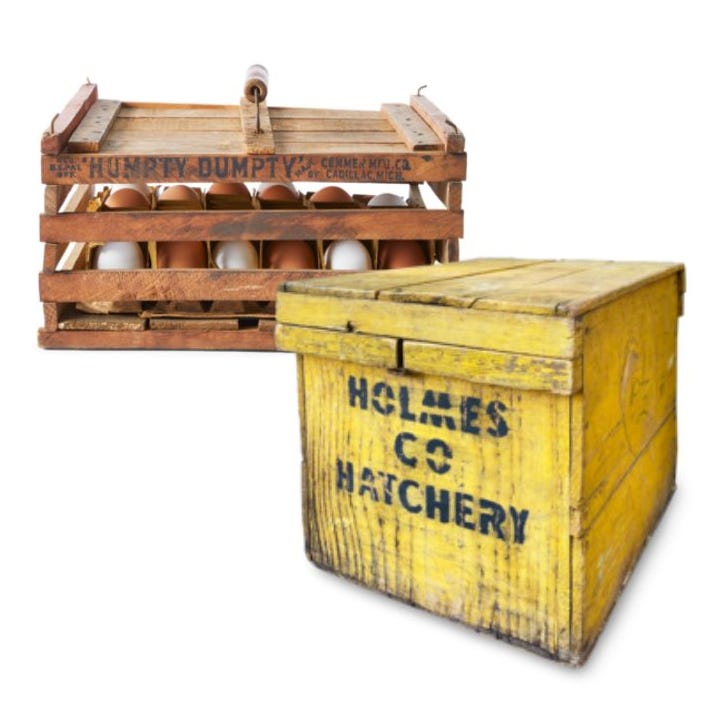Country Living editors select each product featured. If you buy from a link, we may earn a commission. Why Trust Us?
Berry Basket Totes

Typically handmade, wooden berry basket totes have been used to transport precious produce from field to farmstand since the mid-1800s. These flat vessels were made to house small square baskets known as “punnets,” which are shown inside the totes. Their breathable design allows dirt to escape while minimizing handling that could bruise delicate fruits.
What It’s Worth:
Most carriers found today date post-1940 and prices range from $40 to $200, with more elaborate and colorful styles fetching on the higher end. (Farm names and other identifying marks also increase value.) Punnets range from a few dollars for a stack of pressed cardboard types to several dollars each for enamel-rimmed wood examples.
Farmstand Produce Signs

Roadside stands, which proliferated along with the 1920s and ’30s rise of the automobile, have consistently provided an easy and economical way for farmers to profit from their produce. Graphic hand-painted signs advertising available goods (some as large as 6 feet long!) were often displayed well ahead of stopping points so passersby could be on the lookout.
What It’s Worth:
Today, costs range from $50 for smaller, single-word panels to upward of $700 for larger signs that exhibit more artistic flair (see “Raspberries”). Double-sided finds are also worth more, and multiword signs created as a linking set are considered the ultimate prize.
RELATED: The Most Jaw-Dropping Appraisals
Bushel Baskets

Although technically a U.S. dry agricultural measurement equal to roughly eight gallons, the term “bushel” is used generally when referring to this style of open-slat basket that holds orchard produce; the open slats prevent overripening. Collectors often seek out those with colored bands and patterned vinyl linings, which were often repurposed as laundry baskets.
What It’s Worth:
Valued at around $200, bushel baskets from the early 1900s are identified by thick wood panels and bentwood handles (chippy teal, bottom right). Those from the 1940s through ’80s, worth less than $80, are characterized by thinner panels and wire handles.
Advertisement – Continue Reading Below
Field Notes: An Ode to the Honor Stand

Farmers have long relied on the tradition of the honor stand, which includes produce set out alongside a list of prices, a ledger, and an unsupervised box for dropping payment. While not a perfect system, farmers who use it have psychology on their side: Researchers have found that acts of trust-building—even with strangers you don’t directly interact with—induce the release of oxytocin, which can cause temporary surges in generosity, hence the not uncommon tendency for honor stand shoppers to overpay!
Kitchen Scales

Created by Brit Richard Salter in 1770 using good old-fashioned gravity and a physics principle known as Hooke’s Law, spring-style scales are commonly found in kitchens and have been used to weigh farmstand produce in an unofficial capacity for decades. Manufactured by brands such as Landers, Frary & Clark (yellow) and American Family Scale Company (white, green), they saw a particular boom in the homemaker-oriented 1950s and early ’60s.
What It’s Worth:
Scales from the 1950s and early ’60s typically fetch between $40 and $90 depending on age, brand name, uniqueness of design, and working condition. Hanging spring-style scales with coordinating bins often command more than $100.
RELATED: Start a Collection Today with These Fun Kitchen Antiques Kitchen
Chore Coats

The humble and hardworking chore coat was first produced for physical laborers in a vibrant benzoate blue dye in 19th century France. (The piece became known as a bleu de travail, which directly translates to “blue work.”) It arrived stateside in the 1920s and was adapted by farmers for daily wear. The look is characterized by a boxy cut, roomy pockets, and durable fabrics such as canvas and denim. The circa-1930s addition of an insulating corduroy collar, like on this coat by Haik’s, is credited to Carhartt.
What It’s Worth:
Vintage clothing enthusiasts now pay upward of $250 for 1950s- and ’60s-era coats from old-school department stores (look for JCPenney’s “Big Mac” brand). Later iterations by workwear brands such as Dickies and Carhartt can be found for as little as $35.
Advertisement – Continue Reading Below
Field Notes: A Brief History of U-Pick Farms

Post-WWI, a perfect storm of declining birth rates, ballooning debts, and dwindling needs for U.S. agricultural products abroad left farmers desperate to sell surplus produce. At the same time, city dwellers were eager to hit the freshly paved roads that newly connected urban centers to the countryside. During the particularly bountiful 1932 cherry season in Door County, Wisconsin, area farmers arrived at an ingenious idea: turn the hard labor of fruit picking into a leisure activity. Vacationers were heavily encouraged to detour to nearby farms for an afternoon of fruit-focused fun. The coordinated efforts of the Door County cherry farmers paved the way for similar U-pick experiences across the U.S.
Canning Labels

Fruit preserves and canned goods allow growers to profit from produce year-round. As such, gummed canning labels proliferated in the 1930s and ’40s, when extending resources of every sort was particularly essential during World War II. Manufactured by paper product companies, they were also distributed by sugar makers for advertising purposes (bottom right). Collectors especially seek out pieces from Dennison Manufacturing Co., whose plain blue labels (top right) are rarer finds than their red counterparts.
What It’s Worth:
Labels from this era typically run $6 to $15 per set (includes 30-90 labels).
Egg Crates

Used to transport eggs from coop to customer before cartons became commonplace, wooden egg crates kept their cargo from breaking via interlocking cardboard and pressed paper pulp dividers.
What It’s Worth:
Now used mostly for display, traditional open-slat crates from the early 1900s can be found for $40 to $100, with costs varying according to size and condition. Rarer are fully enclosed crates emblazoned with a farm or hatchery name, which can cost up to $1,000. Handled tops also often add to an egg crate’s value.
Advertisement – Continue Reading Below
Start Collecting!

Berry basket carriers: Genesee River Trading
Farmstand signs: Genesee River Trading, Lack Luster Co., Sundries & Salvage, Wyrembelskis Vintage, Richard Romberg Antiques
Bushel baskets: Early Garage Sale, Tangerine Fig, Aunt Sisters’ Picks, Sundries & Salvage, The Vintage Porch, Vintiquing at Home, Karen’s ChicNShabby
For even more fun vintage hunting, shop our list of The 100+ Best Places to Shop for Antiques and Vintage Online
Sarah Zlotnick is the Lifestyle Director at Country Living, where she covers a little bit of everything—small towns, life in the country, and, her favorite, antiques. A research buff at heart, she loves a deep dive into the history of vintage finds and uncovering the reasons behind old-as-time traditions.

Stephanie Gibson Lepore is the Copy/Research Editor of Country Living. She enjoys writing about a range of topics and making sure the facts are accurate. When she’s not checking out the latest Instagram post from Merriam-Webster, you can find her hunting home decor at an antiques shop, reading WWII fiction in a sunny spot, cheering (loudly) for her football team, or planning her daughter’s next birthday party (themes forever!).
Watch Next

Advertisement – Continue Reading Below
Advertisement – Continue Reading Below
Advertisement – Continue Reading Below


